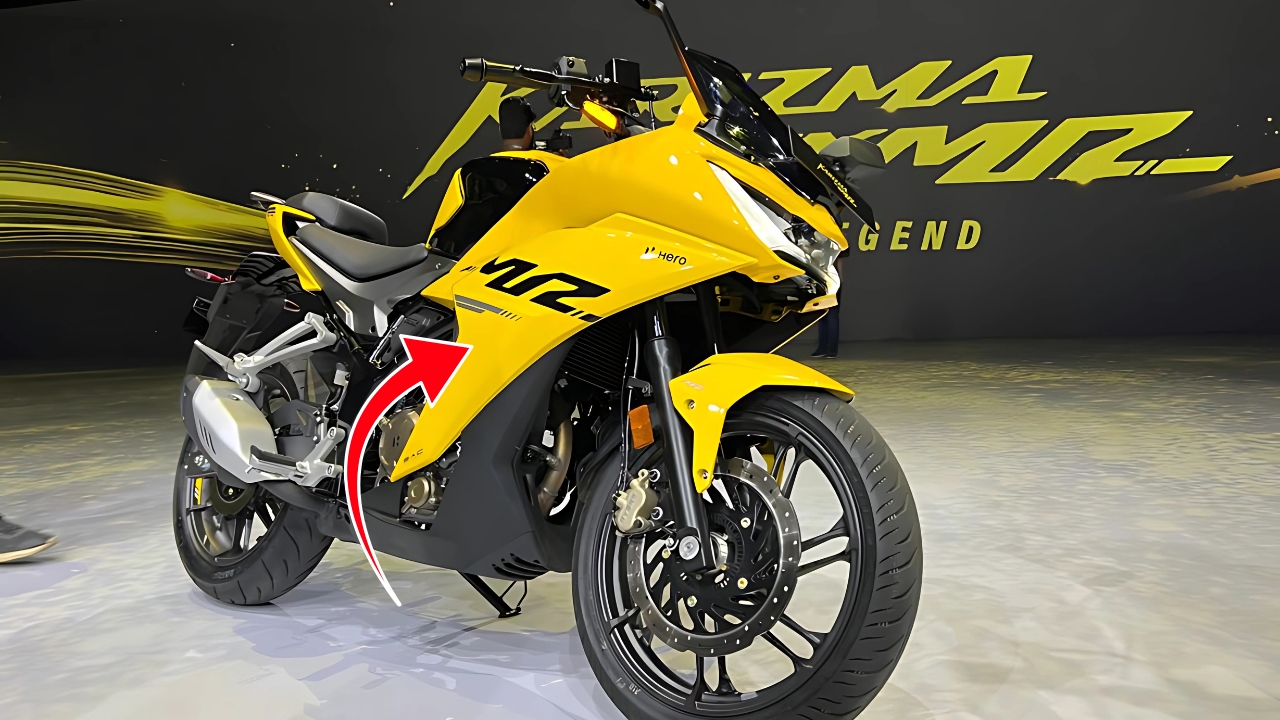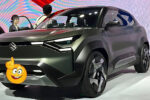Hero Karizma: The reborn Karizma, officially dubbed the Karizma XMR, represents more than just another entry in Hero’s expanding premium lineup.
It embodies the company’s acknowledgment of its heritage while simultaneously showcasing its evolved technical capabilities outside Honda’s shadow.
Unveiled during Hero’s 40th anniversary celebrations, the timing of this resurrection carries symbolic weight—a statement that the company isn’t just looking forward but is confident enough to revisit and reinvent its most emotionally resonant model.
This return wasn’t hastily executed. Hero spent over three years developing the new Karizma, understanding that any motorcycle bearing this storied name would face intense scrutiny.
The strategic importance of getting this revival right cannot be overstated, especially as Hero seeks to establish stronger credentials in the premium segment dominated by competitors like Bajaj, TVS, and former partner Honda.
Hero Karizma: Design Philosophy- Honoring Legacy While Embracing Modernity
The Karizma XMR walks a delicate line between nostalgia and contemporary design. While completely new, the silhouette pays homage to the original with its distinctive sports-touring proportions.
The front fairing, though more angular and aggressive than its predecessor, maintains a familiar presence with its vertically stacked LED headlights echoing the twin circular headlamps of the original.
From the side, the flowing lines and proportions speak to the Karizma’s sports-touring DNA—an identity that distinguished the original from pure sportbikes and made it practical for everyday use.
The fuel tank features pronounced knee recesses for better ergonomic grip during spirited riding, while the stepped seat maintains the two-up comfort that made the original Karizma a capable weekend tourer.
The rear section has received a thoroughly modern treatment with a sharp, upswept tail featuring an LED taillight. Split grab rails and a stubby exhaust complete the contemporary look while maintaining visual balance.
Throughout the motorcycle, subtle design cues—from the shape of the mirrors to certain character lines on the fairing—trigger recognition among those familiar with the original without seeming derivative.
Color options show thoughtful consideration of the model’s heritage. Beyond the obligatory racing red and stealth black, Hero offers a distinctive pearl yellow reminiscent of the iconic yellow often associated with the first-generation Karizma—a deliberate nod to enthusiasts who remember the original in its heyday.
Performance: Heart of the Matter
At the core of any motorcycle bearing the Karizma badge must be an engine that delivers on the promise of performance.
The XMR features an all-new 210cc liquid-cooled, single-cylinder engine—a significant departure from the air-cooled motors of previous Karizmas.
This modern powerplant produces 25.5 horsepower at 9,250 rpm and 20.4 Nm of torque at 7,250 rpm—respectable figures that position it competitively in the 200-250cc segment.
The liquid-cooling system represents Hero’s acknowledgment of evolving emission norms and performance expectations.
It enables higher sustained output while maintaining reliability—crucial for a motorcycle that many owners will use for long-distance touring.
The engine is paired with a 6-speed transmission featuring a slip-and-assist clutch, a premium feature that reduces clutch effort while preventing rear wheel hop during aggressive downshifting.
More than raw numbers, it’s the character of the engine that matters for a model with the Karizma’s legacy.
Hero’s engineers have tuned the powerband to deliver accessible torque in the mid-range, prioritizing real-world rideability over top-end theatrics.
This approach honors the original Karizma’s ethos—a motorcycle that delivered its performance without demanding expert-level riding skills.
Three riding modes—Eco, Sport, and Urban—allow riders to tailor the engine’s response characteristics to different scenarios, from fuel-saving commutes to enthusiastic weekend rides.
This modern touch acknowledges that today’s premium motorcycles must offer versatility to justify their positioning.
Chassis and Dynamics: The Balanced Approach
The Karizma XMR is built around a new tubular frame that prioritizes stability at highway speeds while remaining agile enough for urban navigation.
With a kerb weight of 163.5 kg, it occupies a middle ground—substantially lighter than many full-faired sports tourers but carrying enough mass to remain planted on highway stretches.
The suspension components reflect the motorcycle’s intended use case. The front end features 37mm telescopic forks, while the rear employs a monoshock with 7-step preload adjustability—allowing riders to tune the setup based on load and riding conditions.
The 140mm ground clearance acknowledges Indian road realities without compromising handling dynamics.
Braking duties are handled by a 300mm front disc with a radial caliper and a 230mm rear disc, both supported by dual-channel ABS.
The system offers progressive stopping power with good feel at the lever—crucial for inspiring confidence in both novice and experienced riders.
The wheel and tire combination further emphasizes the Karizma’s balanced nature. The 17-inch alloy wheels come wrapped in 110/70 front and 140/70 rear tires—dimensions that offer a good compromise between agility and stability.
Hero has wisely opted for MRF Nylorex rubber specifically developed for the Karizma XMR, ensuring the tire characteristics complement the motorcycle’s dynamics.
Technology Integration: Modern Expectations Met
Where the new Karizma most dramatically departs from its ancestor is in its technology suite.
The original debuted in an era when a tachometer was considered a premium feature; the XMR enters a market where connected features and digital interfaces are baseline expectations.
The cockpit is dominated by a 5-inch TFT display that offers Bluetooth connectivity with turn-by-turn navigation, call and message alerts, and comprehensive ride telemetry.
The interface can be customized between light and dark themes based on rider preference and ambient lighting conditions.
Hero’s smartphone application enables deeper interaction with the motorcycle, including ride statistics tracking, service reminders, and last parked location—features particularly appreciated by the tech-savvy younger riders the Karizma seeks to attract.
The application also facilitates social sharing of rides, acknowledging the role motorcycling plays in modern digital social identities.
Other thoughtful technological touches include an LED lighting package throughout, USB charging port for devices, and a side-stand engine inhibitor for safety.
While none of these features are revolutionary in isolation, their inclusion demonstrates Hero’s understanding that the premium segment demands comprehensive equipment.
Ergonomics: The Sporting Comfort Zone
The riding position of the Karizma XMR strikes a careful balance between sportiness and comfort—critical for a motorcycle that may serve as both daily commuter and weekend tourer.
The 810mm seat height makes it accessible to riders of various statures, while the relatively upright handlebar position prevents the wrist strain associated with more aggressive sport motorcycles.
The footpeg position continues this philosophy, sporting enough to engage the rider during cornering but relaxed enough to prevent knee discomfort on longer journeys.
This ergonomic triangle—the relationship between handlebars, seat, and footpegs—closely echoes the philosophy of the original Karizma, which was praised for its all-day rideability.
Passenger accommodation hasn’t been sacrificed at the altar of styling. The rear seat offers sufficient width and padding, while the accessible grab rails provide security without awkward reaching.
These considerations matter in the Indian context, where motorcycles often serve as family transportation rather than purely individual indulgences.
Wind protection, a crucial factor for highway comfort, has been addressed through careful aerodynamic development of the fairing.
The windscreen height strikes a balance—tall enough to redirect air pressure away from the rider’s chest at highway speeds but not so tall as to create visibility issues for shorter riders.
Market Positioning and Competition
With an ex-showroom price starting at Rs. 1.73 lakh, the Karizma XMR occupies a strategic position in Hero’s lineup and the broader market.
It sits above Hero’s Xtreme 160R and 200S models, creating a logical progression within the brand’s performance portfolio.
In the wider market, the Karizma faces competition from established players like the Bajaj Pulsar RS200, TVS Apache RTR 200 4V, and Honda Hornet 2.0.
Each competitor offers distinct appeals—the Pulsar with its full-fairing sportiness, the Apache with its race-derived technology, and the Hornet with Honda’s reputation for refinement.
What distinguishes the Karizma in this crowded segment is its balanced approach and the emotional equity of its nameplate.
For riders who remember the original, the new Karizma offers a modernized experience of a motorcycle that may have been their first performance bike aspiration.
For younger riders without this historical connection, the comprehensive feature set and distinctive styling provide sufficient differentiation.
Hero’s extensive dealer network—the largest among Indian two-wheeler manufacturers—offers another strategic advantage.
Potential Karizma owners in smaller towns and cities have accessibility to sales and service that competitors may not match, expanding the motorcycle’s potential market footprint beyond urban centers.
Ownership Experience: Beyond the Product
Understanding that premium segment customers expect more than just the physical product, Hero has developed a specialized ownership program for Karizma buyers.
This includes priority service appointments, dedicated technical support channels, and exclusive community events for owners.
The standard warranty coverage extends to 5 years or 50,000 kilometers, whichever comes first—a statement of confidence in the motorcycle’s build quality and reliability.
Service intervals are set at 6,000 kilometers, longer than many competitors, reducing the total maintenance commitment.
Hero has also developed a range of official accessories for the Karizma XMR, including luggage solutions, enhanced wind protection options, and protection components.
These factory-backed additions allow owners to personalize their motorcycles while maintaining warranty coverage and design cohesion.
Cultural Impact and Community
The original Karizma spawned one of India’s most passionate owner communities, with regional clubs organizing regular rides and meets long after production ceased.
Hero has recognized the value of this community culture, initiating a Karizma Legacy Program that connects new owners with this established enthusiast base.
Dedicated Karizma ride events, technical workshops, and touring programs help foster the sense of belonging that characterized the original ownership experience.
In an era of increasingly digital interaction, these tangible community connections offer substantial value for enthusiasts seeking authentic motorcycling culture.
Social media channels dedicated to Karizma owners provide platforms for sharing experiences, technical knowledge, and modification ideas—creating an ecosystem that extends the ownership experience beyond the individual relationship with the motorcycle.
Hero Karizma: A Legacy Continued
The revival of the Karizma nameplate represents more than just another model in Hero MotoCorp’s lineup—it’s a statement of the company’s confidence in its heritage and technical capabilities.
By acknowledging the emotional connection many riders have with the original while thoroughly modernizing the experience, Hero has created a motorcycle that can appeal across generational lines.
For older riders, the new Karizma offers a chance to reconnect with a nameplate that may have defined their early riding experiences.
For younger enthusiasts, it provides a distinct option in a segment often characterized by similar approaches to performance and styling.
The true test of this resurrection will come not just in initial sales figures but in whether the new Karizma can generate the same passionate community and lasting cultural impact as its predecessor.
If riders embrace this new interpretation with the same enthusiasm that greeted the original, the Karizma nameplate may well secure another decade of relevance in India’s evolving motorcycling landscape.
As the motorcycle market continues its upward shift toward higher displacement and premium features, the Karizma XMR serves as a bridge—connecting Hero’s commuter-focused past with its aspirations in the performance segment.
In that transitional role, it carries not just the hopes of the company but the expectations of a generation of riders who first experienced the thrill of performance motorcycling with the letters “Karizma” proudly displayed on their fuel tanks.



